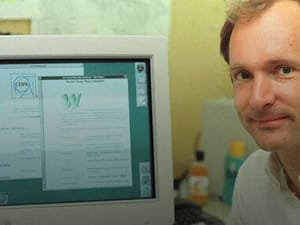Ever wondered who spun the web of the internet?
Tim Berners-Lee: A name behind our digital reality.
The Genesis of a Digital Revolution
In the realm of technology and innovation, few names resonate as profoundly as Tim Berners-Lee’s. As a seasoned technology manager with a rich background in software development, Agile project management, and Scrum, I’ve always been fascinated by Berners-Lee’s groundbreaking contribution to the digital world: the invention of the World Wide Web.
The Spark of Inspiration
It was 1989 when Tim Berners-Lee, a software engineer at CERN, envisioned a system to meet the demand for information-sharing among physicists in universities and institutes worldwide. His idea? A web of information nodes in which any node could link to any other. This concept, initially dubbed “Mesh,” laid the groundwork for what we now know as the Internet.
Weaving the Web
Berners-Lee’s idea was revolutionary yet grounded in simplicity. He proposed a hypertext system, using a technology known as HTML (Hypertext Markup Language), to create a network of interconnected documents. These documents were to be accessed via the Internet, a global network that had been growing since the 1970s. This was complemented by the invention of the URL (Uniform Resource Locator) and HTTP (Hypertext Transfer Protocol), the foundational technologies that made the web user-friendly and accessible.
The Impact on Software Development and Beyond
The invention of the web revolutionised not just how we access information, but also how we develop software. It paved the way for web application development, mobile application development, and numerous other fields. As someone who has led digital transformation initiatives and built development teams, I can attest to the profound impact of Berners-Lee’s invention on our work and methodologies.
A Foundation for Agile and Lean Practices
The web’s collaborative nature has been a boon for Agile and Lean methodologies. It has enabled real-time communication, distributed project management, and a plethora of tools for efficient workflow management. In my experience, implementing Scrum and Kanban has been vastly facilitated by the web’s capabilities, allowing for seamless integration of tools like JIRA and Confluence in managing complex projects.
Digital Transformation and IT Governance
In the arena of IT governance, the web has been instrumental. Frameworks like COBIT and ITIL have been integral in managing the risks and ensuring the governance of IT resources in a web-dominated era. In managing IT service desks and overseeing cloud computing strategies, the web’s influence is unmistakable.
In the Words of a Visionary
Reflecting on Berners-Lee’s legacy, a quote by Steve Jobs comes to mind: “Innovation distinguishes between a leader and a follower.” Indeed, Tim Berners-Lee’s innovation has not only made him a leader in technology but also transformed each one of us into innovators in our own right.
The Road Ahead
As we continue to navigate the ever-evolving landscape of technology, it’s crucial to remember the roots from which our digital ecosystem sprang. Tim Berners-Lee didn’t just create a tool; he laid the foundation for a more connected and collaborative world.
In conclusion, as we stand on the shoulders of giants like Tim Berners-Lee, let’s not just marvel at the web he wove. Let’s also weave our own paths in this vast, interconnected world, armed with the tools and technologies he gifted us. The web is our loom, and the threads of innovation are in our hands. Let’s continue to create, connect, and transform – one click, one code, one connection at a time.
